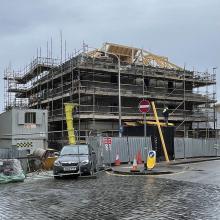
Public libraries have been squeezed and under threat for many decades; a manifestation of a long-running assault on the public domain, writes Charlie Ellis. Thankfully, many in this city seem to be in good health. One of Edinburgh’s busiest public libraries, McDonald Road, is currently celebrating its 120th anniversary. They have been commemorating this with exhibitions and a series of talks.
The local author, social worker and tour guide Tim Bell kicked off the series with a rich and engaging (and at times moving) talk on the history of Leith and Leith Walk – ‘Small Talk on the Walk’. The room was packed – the healthy appetite for local history in this area was clear. Interweaved in his narrative were some of the themes from his book Choose Life, Choose Leith, (a 2nd edition is due out later this year), which looked at the social background to Irvine Welsh’s Trainspotting. Bell has had a long relationship with the book, evident in the battered copy he read from; full of post-its, and with its binding falling apart.
Underlying his talk were themes of social regeneration achieved through culture. Bell has been a leading figure in the Leith Writings project, which has so far produced three volumes of short stories, poetry and drawings offering delightful sketches of Leith. The contributors to these volumes are locals, with a high proportion written by school pupils (especially from Trinity Academy). The project is ‘self-consciously community-orientated’, with the contributors reflecting the changing character of Leith. Contributors this year include a young Ukrainian girl and a Muslim German.
A considerable place
Bell began the main part of his talk picking out key aspects of Leith’s evolution and its often tense relationship with Edinburgh. Its status as a highly significant port and industrial centre saw it become a considerable place in its own right. There was a short period where it was possible to say that ‘Edinburgh was a suburb of Leith’, not vice versa. For example, Leith Races were the biggest social event in Scotland in pre-industrial days. Leith was also the true home of golf, with the original rules drawn up by John Rattray at Leith Links. Bell was part of the effort by the Leith Rules Society to get a statue of Rattray installed on the links; made of bronze by Scottish sculptor David Annand, it sits near the junction of Salamander Place and Links Place.
Bell was keen to remind the audience of the scale of industry in Leith. Salamander Street was a hugely industrial area, often referred to as ‘the street with a hundred smells’. The area where Ocean Terminal now sits was a shipyard. It was because of this significant industrial base that de-industrialisation hit Leith particularly hard. From the 1960s onwards, the area went through massive change. The loss of the old Kirkgate and its ‘organic intimacy’ typified this sense of decline. Significant institutions closed including Leith Theatre and a hospital, creating a sense of lost civic pride. Many people were moved out of the slum areas to some of the peripheral housing schemes, such as Craigmillar; with them went large chunks of the old Leith community. The mammoth blocks of flats built in that era proved largely unsuccessful, with 50 per cent of them now demolished. As Bell remarked, ‘What a waste!’
Hollowing-out
For Bell, the fate of the old Leith Central Station, opened in 1903, closed in 1953, and finally demolished in 1989, typified this hollowing-out. The loss of this vast building was a ‘huge, wasted opportunity’. The sheer scale of it meant there had been so much potential as a focal point for regeneration in the area, some sort of arts complex. (An architect Bell showed round said ‘You could have put a Guggenheim in there!’) In recent decades we have seen a far greater willingness to try to find new uses for old buildings. Perhaps such a place could be mothballed rather than allowed to disintegrate and fall victim to vandalism today? However, finding new uses is never easy, as evidenced by places such as the Custom House. Similarly, the process of finding a new public use for the Old Royal High School has been tortuous.
The fate of the Leith Central Station was, for Bell, an example of lost potential and the way that so many lives were wasted during these hard years of industrial decline. As Bell noted, it all happened so quickly – so many were left scrabbling around to find alternative employment. Surviving the shipwreck, to use William McIlvanney’s description of the impact of Thatcherism on Scotland, was far from easy. Hard drugs became an escape for many. The dealing culture which emerged, in places such as Albert Street, sent Leith further down a spiral. Leith grew in notoriety, often shunned by respectable Edinburgh.
Bell ended powerfully by reflecting on the photo which adorns the front cover of his book. It’s of a group of young men near the Foot of the Walk, taken shortly before World War I. It made him think of a similar group of young men standing there in the 1980s. In the case of the old photo, many of those featured would die in the war. In the 1980s, many of the equivalent group would have their lives wrecked and shortened by drug abuse. Bell himself is closely involved in the world, working with the Anyone’s Child organisation which campaigns for safer drug control.
The way that the area’s image has changed radically in recent decades makes it difficult to comprehend this dark period in its history. These days Leith is seen, by the likes of Donald Anderson, as a classic example of successful urban renewal (or gentrification, depending on your point of view). Its creative energy and dynamism certainly draw many to it.

An unhealed scar
After the talk I made my way down the Walk, enjoying the crisp sunshine. Towards the Foot of the Walk I stopped for a coffee – I needed somewhere to sit and absorb what I had heard. The specialty coffee place I sat in used to be a funeral directors: a rather clear manifestation of rebirth. The many new businesses in this section of the Walk (such as Argonaut Books) seem to represent the contemporary media cliché of an area which has changed out of all recognition and is now one of Europe’s ‘coolest neighbourhoods‘ .
But, as I gazed across at the last remnants of Leith Central Station, Bell’s recounting of the gloomy social realities jolted me out of my daydream. Caffeinated, I made my way across, dodging trams, to Tesco’s car park, where the sidewall of the station remains like the last vestige of a ruined fort. This gives some inkling as to the truly massive scale of the site and the way it continues to represent an unhealed scar in the heart of Leith.
Charlie Ellis is a researcher and EFL teacher who writes on culture, education and politics.



